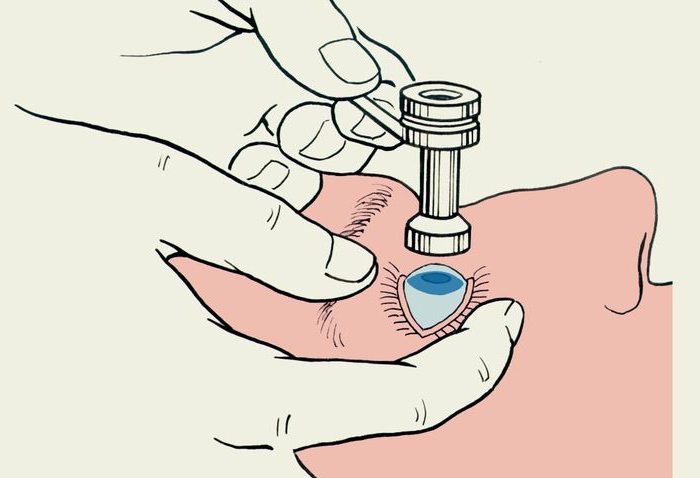The pressure inside the eye chambers is determined by the difference in the rate of inflow and outflow of fluid from them. Clinical methods used in clinical practice (blood pressure measurements) are indirect and give a tonometric pressure indicator.
Measurement of intraocular pressure is very important for the diagnosis of glaucoma and timely ophthalmic care for patients.
Maklakov tonometer in ophthalmotonometry
In domestic ophthalmology, non-contact tonometry and measurement of intraocular pressure according to Maklakov are most often used. The latter was proposed in 1884, and entered into widespread practice a little later.
Maklakov tonometry consists in the short-term installation of a weight (tonometer) on the cornea of the eye and obtaining an imprint of the contact surface. According to its area, an indicator of intraocular pressure is established.
In addition to the territory of the CIS, the method is widely used in China.
Maklakov eye tonometer - completeness and device design
The tonometer kit includes:
- two cylindrical weights weighing 10 g, expanded at the ends with flat end surfaces;
- holder for measurements, in which both weights can be fixed at the same time;
- 3 measuring rulers for assessing the diameter of the fingerprint or the ruler of Professor B. Polyak;
- case.
Loads are hollow inside, contain a lead weighting agent. Their end surfaces are made of frosted glass, which allows you to evenly hold the coloring solution.
The holder is needed so that during measurements with your fingers you do not create excessive pressure on the Maklakov tonometer.
Tonometer Instructions
Before starting work, it is necessary to check the condition of the tonometer. Violation of the integrity of the end pads can lead to damage to the cornea of the patient’s eyes. In addition, the cylinder should easily walk in the gap of the holder.
Processing of Maklakov tonometers before use consists in wiping the sites with alcohol, after which the device is dried for 15-30 seconds.
Boiling sterilization in a 2% solution of drinking soda for 30 minutes is carried out only in cases of emergency:
- when a patient with signs of conjunctival inflammation was examined;
- in case of threat in the department of viral keratoconjunctivitis.
Since the Maklakov tonometer is leaky, water can get into it when boiled. So that the results of ophthalmotonometry are not distorted due to a change in the mass of the device, it is dried for an hour or more on a sterile gauze cloth.
The paint applied to the Maklakov tonometer is collargol (colloidal silver with albumin), rubbed in a mixture of glycerol and water. You can use dyes Bismarck-brown or methylene blue. To cover the plates with paint, use a stamp pad or transfer a drop of the prepared dye with a glass rod, and then rub it with a cotton swab. The latter method is safer in the epidemic plan.
Methods of investigation of intraocular pressure with a Maklakov tonometer
Before tonometry, the patient's eyes are anesthetized. For this, a solution of dicaine is instilled into the conjunctival sac twice with an interval of 2 minutes. The patient between instillations covers the eyelids.
Next, the doctor or nurse performs the actions in the following order:
- Disinfection of Maklakov tonometers with alcohol is carried out, they are dried.
- A thin layer of paint is applied to the tonometer sites.
- The patient lies on the couch without a pillow, slightly raising his chin, fixes his gaze on the index finger of his outstretched arm. The central part of the cornea should be in a horizontal position.
- With the fingers of one hand, the researcher expands the palpebral fissure so that the eyelids do not exert pressure on the eyeball.
- With the other hand, with the help of the holder from above, he lowers the Maklakov tonometer with a painted platform on the center of the cornea. The weight should fall completely on the eye with all its weight.
- Then the load is quickly lifted and imprinted on paper moistened with alcohol.
- The study is repeated for the second eye.
- The patient's eyes are washed from the paint with saline and instilled with albucid.

While lowering the tonometer onto the cornea, the paint in the area of contact is washed off with a tear. As a result, the print is a ring.
Interpretation of the results of ophthalmotonometry according to Maklakov
The diameter of the light circle on the print is proportional to the degree of flattening of the cornea during the study. Accordingly, the higher the pressure, the less ink will be removed and, accordingly, the less light area of the print.
A transparent ruler measures the diameter of the light area. The researcher should place it on a scale down to avoid distortion. The result is evaluated through a binocular magnifier. The scale applied to the ruler allows you to immediately translate the result into millimeters of mercury.
When measured with a standard ruler (up to 0.1 mm), the pressure indicator is calculated as a ratio to the tonometer weight: the square of the print radius by the number Pi and the specific gravity of mercury (13.6).
The norm of eye pressure according to Maklakov is an interval of 18-26 mm RT. Art.
Limitations and features of the method
Maklakov tonometry is not recommended in the following cases:
- after surgery on the eyeball;
- with an allergic reaction to an anesthetic;
- with inflammation of the eyes and membranes.
The Maklakov tonometer exerts pressure on the eyeball that exceeds this indicator in other methods, respectively, the norm of the result is shifted upward. For comparison, Goldman's normal eye pressure is 9–21 mmHg. Art. Therefore, a comparison of the results obtained by different methods will not be correct.